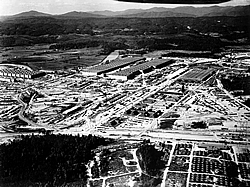K-25 and S-50 Uranium and Fluoride Releases

Aerial Photo of K-25 Facility
Public Health Assessment
- K-25 and S-50 Uranium and Fluoride Releases [PDF, 7.5 MB]
In 1942, the federal government established the K-25 site and the S-50 site at the Oak Ridge Reservation to produce enriched uranium for nuclear weapons. In October 1944, the S-50 plant began separating uranium by liquid thermal diffusion, but closed less than one year later in September 1945. In 1946, all of the buildings associated with the S-50 site were destroyed.
The K-25 site (formerly referred to as the Oak Ridge Gaseous Diffusion Plant) remained operational from 1945 to 1964, enriching weapons-grade uranium through gaseous diffusion. From 1965 to 1985 at K-25, uranium hexafluoride subjected to the gaseous diffusion process became commercial-grade uranium. In 1985, all gaseous diffusion operations ceased at K-25, and in 1987, the site closed. The K-25 site is currently known as the East Tennessee Technology Park. In the past, these K-25/S-50 operations generated a variety of radioactive and nonradioactive wastes and consequently some waste was released into the environment.
ATSDR’s Public Health Assessment
The Agency for Toxic Substances and Disease Registry (ATSDR) conducted a public health assessment (PHA) [PDF, 7.5 MB] on the historical air releases from the K-25/S-50 sites. ATSDR evaluated potential past short-term (acute) and long-term (chronic) off-site exposures from K-25/S-50 air releases of ionizing radiation, uranium, hydrogen fluoride, and fluoride that took place from 1944 to 1995. ATSDR evaluated exposures for three communities which had the highest potential exposures based on proximity:
- Happy Valley
- Sugar Grove
- Union/Lawnville.
ATSDR evaluated potential current and future hazards that might be identified during ongoing remedial activities at the K-25 site.
General Conclusions
ATSDR concluded that current and future off-site exposure to potential air releases of uranium, radioactive materials, hydrogen fluoride, and fluoride from the K-25/S-50 sites will not harm the health of those living near the site. People are not currently exposed to these contaminants nor are they expected to be exposed in the future.
ATSDR concluded that in the past the estimated levels of uranium, hydrogen fluoride, fluoride, and radioactive materials from historical K-25/S-50 air releases into nearby off-site community air are lower than generally accepted harmful health levels. Off-site residents’ short-term (acute) and long-term(chronic) breathing of low levels of uranium, hydrogen fluoride, fluoride, and other radioactive materials from 1944 to 1995 was not expected to have harmed their health.
ATSDR also concluded that not enough data exists to determine if past short-term (acute) breathing of fluoride and hydrogen fluoride from the large, sudden releases of uranium hexafluoride (UF6) in the 1940s and 1950s during accidents and equipment maintenance at the K-25/ S-50 site could have harmed people’s health.
Contact Us:
- Agency for Toxic Substances and Disease Registry
4770 Buford Hwy NE
Atlanta, GA 30341-3717 USA - 800-CDC-INFO
(800-232-4636)
TTY: (888) 232-6348
Email CDC-INFO - New Hours of Operation
8am-8pm ET/Monday-Friday
Closed Holidays


